中国传统婚礼习俗英文版汇编
中式婚礼风俗作文英语

中式婚礼风俗作文英语Title: Traditional Chinese Wedding Customs。
In China, weddings are not just about the union of two individuals but also a celebration deeply rooted incultural traditions that have been passed down through generations. From elaborate ceremonies to symbolic rituals, a Chinese wedding is a reflection of centuries-old customs and beliefs. Let's delve into some of the key aspects of a traditional Chinese wedding.1. Betrothal Gifts: Before the wedding ceremony takes place, the groom's family traditionally presents betrothal gifts to the bride's family. These gifts, known as "pin jin" or betrothal money, symbolize the groom's sincerity and ability to provide for the bride. The items included in the betrothal gifts vary but often include tea, jewelry, and other valuable goods.2. Setting the Date: The selection of an auspiciouswedding date is crucial in Chinese culture. Couples consult a lunar calendar and often seek the advice of a fortuneteller to ensure that the chosen date aligns with favorable cosmic forces. Dates that are considered lucky, such as those with the number eight, are highly preferred.3. The Wedding Day: On the wedding day, the bride typically begins her day by undergoing traditional bridal preparations, which may include hair styling and makeup application. Red is the predominant color worn by the bride, symbolizing joy, luck, and prosperity. The groom also dresses in red to complement the bride.4. The Tea Ceremony: One of the most significantrituals in a Chinese wedding is the tea ceremony, known as "cha xi." During this ceremony, the newlyweds serve tea to their parents and elders as a gesture of respect and gratitude. It symbolizes the formal introduction of thebride into the groom's family and the acknowledgment oftheir new roles as husband and wife.5. Exchange of Vows and Rings: Similar to Westernweddings, Chinese couples often exchange vows and rings asa declaration of their commitment to each other. However, these exchanges may occur within the confines of atraditional ceremony, which may include rituals such as the lighting of unity candles or the sharing of "double happiness" candies.6. Banquet Reception: Following the wedding ceremony, a lavish banquet reception is held to celebrate thenewlyweds' union. Family members, friends, and other guests gather to enjoy sumptuous feasts, lively entertainment, and heartfelt speeches. Red envelopes containing money, knownas "hong bao," are often given to the couple as a token of good wishes and blessings.7. Door Games: In some regions of China, the groom and his groomsmen must undergo a series of playful challenges, known as "door games," before being granted entry to the bride's home. These games are designed to test the groom's sincerity and determination and often involve tasks that require wit, agility, and sometimes even physical endurance.8. Firecrackers and Dragon Dances: To ward off evil spirits and bring good luck to the newlyweds, firecrackers are often set off during various stages of the wedding celebration. In addition, colorful dragon dances may be performed, especially in southern China, to add to the festive atmosphere and symbolize prosperity and happiness.In conclusion, a traditional Chinese wedding is a harmonious blend of ancient customs, symbolism, and modern elements. It not only serves as a joyous occasion for the couple and their families but also as a continuation of cultural heritage and beliefs. Through rituals such as the tea ceremony, exchange of vows, and banquet reception, Chinese weddings embody the values of respect, harmony, and prosperity that have been cherished for centuries.。
传统中国婚礼的风俗英语作文
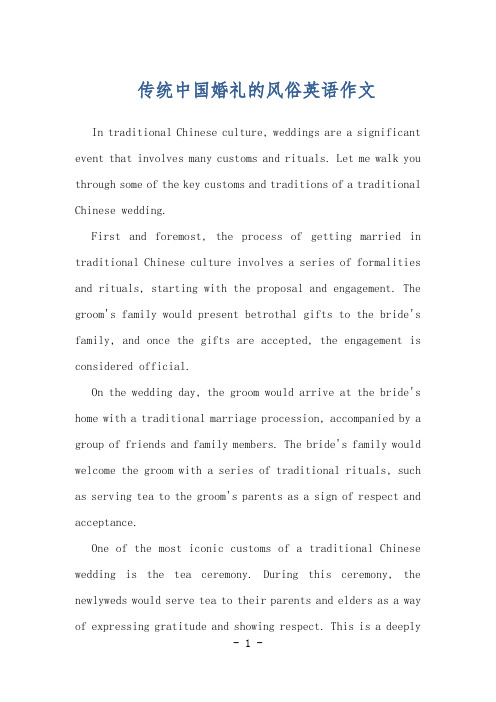
传统中国婚礼的风俗英语作文In traditional Chinese culture, weddings are a significant event that involves many customs and rituals. Let me walk you through some of the key customs and traditions of a traditional Chinese wedding.First and foremost, the process of getting married in traditional Chinese culture involves a series of formalities and rituals, starting with the proposal and engagement. The groom's family would present betrothal gifts to the bride's family, and once the gifts are accepted, the engagement is considered official.On the wedding day, the groom would arrive at the bride's home with a traditional marriage procession, accompanied by a group of friends and family members. The bride's family would welcome the groom with a series of traditional rituals, such as serving tea to the groom's parents as a sign of respect and acceptance.One of the most iconic customs of a traditional Chinese wedding is the tea ceremony. During this ceremony, the newlyweds would serve tea to their parents and elders as a way of expressing gratitude and showing respect. This is a deeplysymbolic and important tradition that signifies the union of two families.Another important aspect of a traditional Chinese wedding is the exchange of vows and rings. The bride and groom would make their vows in front of their families and friends, and exchange rings as a symbol of their commitment to each other.In terms of attire, the bride would typically wear a traditional red qipao or cheongsam, which symbolizes joy and good luck in Chinese culture. The groom would wear a traditional black silk coat with a mandarin collar, paired with black trousers.The wedding banquet is also a crucial part of a traditional Chinese wedding. It is a grand affair that involves a lavish feast with multiple courses, and is a way for the newlyweds to express their gratitude to their guests. During the banquet, there are often performances, toasts, and well-wishes from the guests.After the wedding, the bride would traditionally move into the groom's home and become a part of his family. This transition is marked by a series of rituals and customs that symbolize the bride's acceptance into her new family.Overall, a traditional Chinese wedding is a rich andmeaningful event that is steeped in centuries of customs and traditions. It is a celebration of love, family, and the joining of two lives, and is a reflection of the deep cultural heritage of the Chinese people.传统中国婚礼是一个意义重大的事件,涉及许多风俗和仪式。
中国传统婚礼习俗英文版
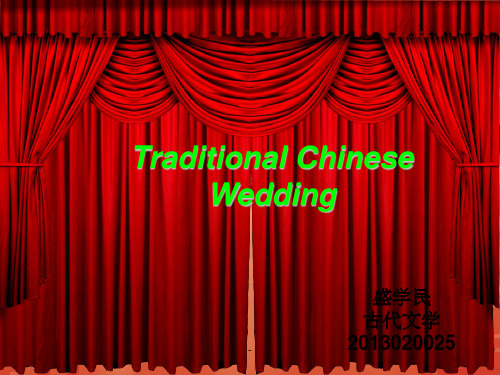
part three 纳吉
The groom's side divines there will be a auspicious fortune, then they prepare gifts for the ceremony, and make a notice to the bride's side, the wedding tentatively agreed
-
纳采
part two 问名
It commonly known as the horoscopes, asked the matchmaker to ask the woman birth and name, so that they will know if they are suitable for each other
Traditional Chinese Wedding
盛学民
古代文学
-
2013020025
纳采
问名
纳吉
Six kinds of etiquette
纳征
请期
亲迎
2
part one
It commonly known as Байду номын сангаасatchmaking, the man ask matchmaker to went to the woman's home to propose marriage , when the woman's family agreed to the marriage proposal, then the man went home to prepare gifts to the proposal
-
part four 纳征
中式婚礼的流程英文版
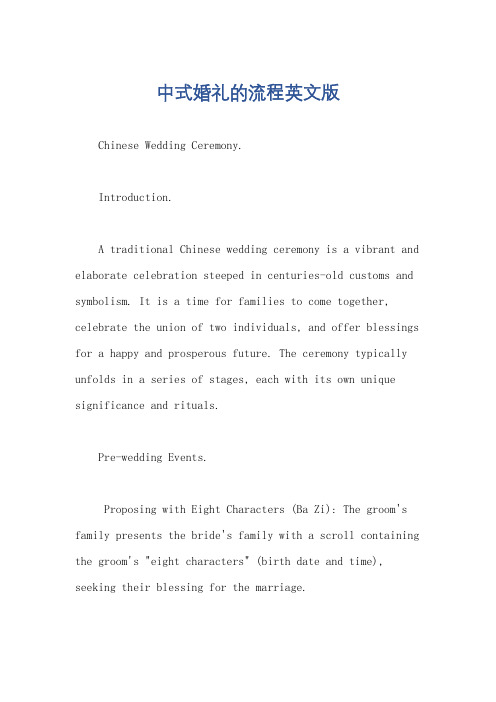
中式婚礼的流程英文版Chinese Wedding Ceremony.Introduction.A traditional Chinese wedding ceremony is a vibrant and elaborate celebration steeped in centuries-old customs and symbolism. It is a time for families to come together, celebrate the union of two individuals, and offer blessings for a happy and prosperous future. The ceremony typically unfolds in a series of stages, each with its own unique significance and rituals.Pre-wedding Events.Proposing with Eight Characters (Ba Zi): The groom's family presents the bride's family with a scroll containing the groom's "eight characters" (birth date and time), seeking their blessing for the marriage.Selecting an Auspicious Date: The wedding date is chosen carefully based on Chinese astrology to ensure good luck and prosperity for the couple.Presenting Gifts (Guo Da Li): The groom's family presents an elaborate dowry to the bride's family, including jewelry, silks, and tea, symbolizing their respect and support.Wedding Day.Groom's Procession: The groom arrives at the bride's home accompanied by a procession of musicians and helpers carrying the dowry gifts.Firecrackers and Drumming: Firecrackers are set off and drums are played to announce the groom's arrival and ward off evil spirits.Tea Ceremony: The bride and groom serve tea to their parents and other elders, symbolizing respect and filial piety.Bridal Chamber Unveiling: The couple is led to the bridal chamber, where they are expected to spend theirfirst night together.Parent's Blessings: The couple receives blessings and advice from their parents, who wish them a long and happy life together.Wedding Banquet: A grand feast is held to celebrate the marriage, with guests enjoying traditional dishes and entertainment.Post-wedding Customs.Return to the Bride's Home (Shuiqin): The bride and groom return to the bride's home for a three-day stay, where they receive gifts and well-wishes from both sides of the family.First Visit to the Ancestral Temple: The couple visits the groom's ancestral temple to pay respects to hisancestors and seek their blessings.Hair Combing Ceremony: The bride's hair is combed by her mother-in-law, symbolizing her transition into her new family.Symbolism.Red: Red is considered a lucky color in Chinese culture and is used extensively in wedding decorations, clothing, and gifts. It symbolizes joy, prosperity, and good luck.Dragon and Phoenix: The dragon and phoenix are mythical creatures that represent the bride and groom, respectively. They symbolize harmony, love, and eternal happiness.Double Happiness Symbol: This symbol, often depicted in red or gold, consists of two characters that when combined mean "double happiness." It is a popular decoration for weddings and represents the couple's desirefor a long and happy life together.Tea Ceremony: Offering tea to elders symbolizesrespect and humility, and strengthens the bond between the couple and their families.Firecrackers: The loud noise of firecrackers is believed to scare away evil spirits and bring good fortune.Modern Adaptations.While many traditional customs remain, modern Chinese weddings have incorporated some Western influences, such as:White Wedding Dress: Many brides now wear white wedding dresses, symbolizing purity and virginity.Wedding Cake: A tiered wedding cake is often served as a dessert, representing the couple's sweet future together.Wedding Vows: Couples may choose to exchange personal wedding vows, expressing their love and commitment to eachother.Ultimately, a Chinese wedding ceremony is a unique and meaningful cultural event that symbolizes the love, unity, and good wishes for two individuals beginning their lives together.。
英文介绍中国传统婚礼
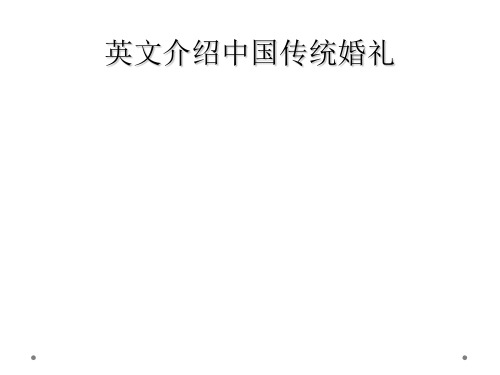
(拜堂)
and drinking wedlock wine(喝交杯酒)
2021/7/17
2
match-making
2021/7/17
3
2021/7/17
engagement
4
betrothal presents
2021/7/17
5
meeting the bride
2021/7/17
6
three bows
21
Thank you !
2021/7/17
22
Thank You ! 不尽之处,恳请指正!
The fourth combing summaries good wealth and a long-lasting marriage.婚姻长久
The whole action also symbolizes the adulthood of the couple.
2021/7/17
12
Chinese Wedding Customs 【Crying marriage哭嫁】
2021/7/17
18
teasing the bride and the bridegroom on wedding night 闹洞 房
2021/7/17
19
The wedding ceremony is held in a church or outdoor
2021/7/17
20
2021/7/17
The first combing symbolizes: from beginning till the end.自始lizes: harmony from now till old age.和睦永远
英语中国传统婚礼习俗
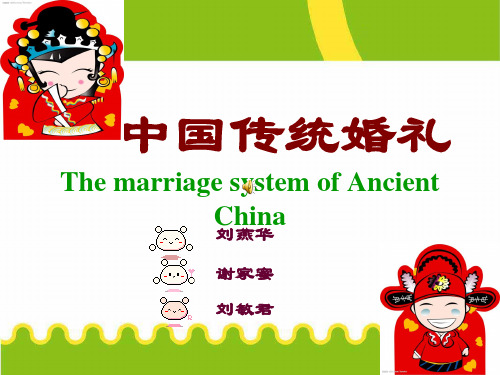
The marriage system of Ancient C刘h燕i华na
谢家蜜 刘敏君
• China is a large country with 56 nationalities.Different nationalities have different marriage customs, but whatever the nationality is, the wedding ceremony is usually very complicated. The traditional Chinese marriage usually involves 6 necessary procedures。
花轿bride's sedan
迎亲的行列
• music and firecrackers.
Kick the curtain of the sedan chair (轿子) 踢轿门
Purpose:to kicked off the bride‘s pride去傲气
Stride the fire pan 跨火盆
• The main 6 necessary procedures of the wedding
• match-making (说媒)
• Engagement (定亲)
• betrotheeting the bride (迎娶)
• three bows
(拜堂)
• and drinking wedlock wine(喝交杯酒)
• Purpose: To counteract evil force 辟邪
• 二.陪嫁女婢
• some maids might be sent to marry her hostess’ husband-to-be by the sedan carried by two men.
中式婚礼的习俗英语作文

中式婚礼的习俗英语作文Chinese Wedding CustomsIn traditional Chinese culture, wedding ceremonies are often elaborate and follow a set of time-honored customs. Here are some common Chinese wedding customs:The Engagement: Before the wedding, a formal engagement ceremony is usually held. This involves the exchange of gifts and the determination of the wedding date.Hairdressing and Makeup: On the wedding day, the bride will have her hair styled and apply beautiful makeup, symbolizing her new identity as a bride.Wedding Dress and Attire: The bride typically wears a red gown, which represents prosperity and good luck. The groom wears a traditional Chinese suit.牺舆: The groom arrives at the bride's home in a decorated carriage or vehicle, accompanied by a procession.Door-Blocking and Bride's Request: The groom and his party may face some challenges or games before entering the bride's house, as a form of守门and adding to the joyous atmosphere.Tea Ceremony: After the groom enters, a tea ceremony is conducted where the bride and groom serve tea to their parents and elders as a sign of respect and gratitude.Wedding Ceremony: The actual wedding ceremony takes place, usually in a ceremony hall or a designated venue. The couple exchanges vows, rings, and performs other traditional rituals.Banquet: A grand wedding banquet is hosted to celebrate the occasion. Guests enjoy a delicious meal and exchange well wishes with the newlyweds.These are just some of the common customs in Chinese weddings, and there may be variations depending on regional and personal preferences. Each custom carries its own significance and adds to the uniqueness and charm of a Chinese wedding celebration.。
中国婚礼习俗英文作文
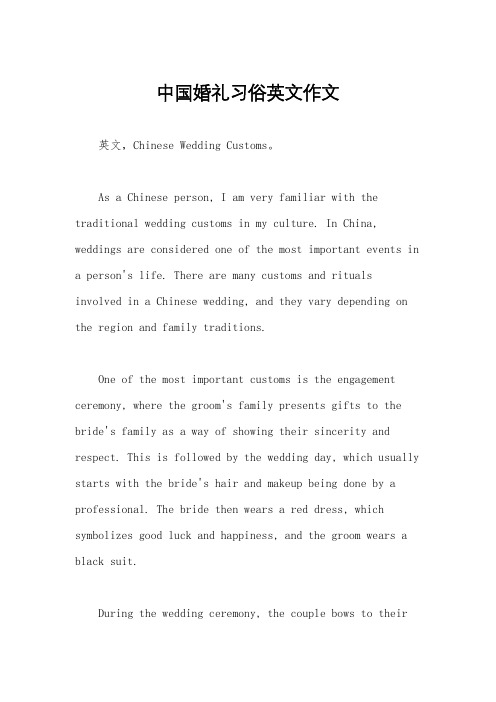
中国婚礼习俗英文作文英文,Chinese Wedding Customs。
As a Chinese person, I am very familiar with the traditional wedding customs in my culture. In China, weddings are considered one of the most important events in a person's life. There are many customs and rituals involved in a Chinese wedding, and they vary depending on the region and family traditions.One of the most important customs is the engagement ceremony, where the groom's family presents gifts to the bride's family as a way of showing their sincerity and respect. This is followed by the wedding day, which usually starts with the bride's hair and makeup being done by a professional. The bride then wears a red dress, which symbolizes good luck and happiness, and the groom wears a black suit.During the wedding ceremony, the couple bows to theirparents and then to each other as a sign of respect and gratitude. They also exchange rings and drink from a cup of wine together. After the ceremony, the couple goes to the groom's house to start their new life together.Another important custom is the wedding banquet, where the couple invites their family and friends to celebrate their marriage. The banquet usually includes many courses of delicious food and lots of toasting and speeches.中文,中国婚礼习俗。
英语版 中国文化-传统婚礼

8. Avoid bride turning back her head when leaving parents. Reason: Not turning the head means the bride will never repent.
9 . The new dress must be made with a piece of cloth. Avoid using two pieces of cloth. Reason: Using just one piece of cloth means the bride and bridegroom will be single-mindedness(一心一意,不分开) 10. The bride's dress avoid pockets. Reason: The bride's dress always have no pockets in order to avoid taking away her family's good fortune .
2、Avoid to have two wedding ceremony in the same family in one year. Within a family, if a son get married, the daughter can‟t wed in this year. In the same year, a family is just allowed one couple to wed. 3、Avoid to have wedding ritual during mourning.(服丧) During this perioud, the members of the family can‟t get married. It is said that if they get married, their children will be hard to grow up and the fortune of the family will be bad.
中式婚礼的流程英文版
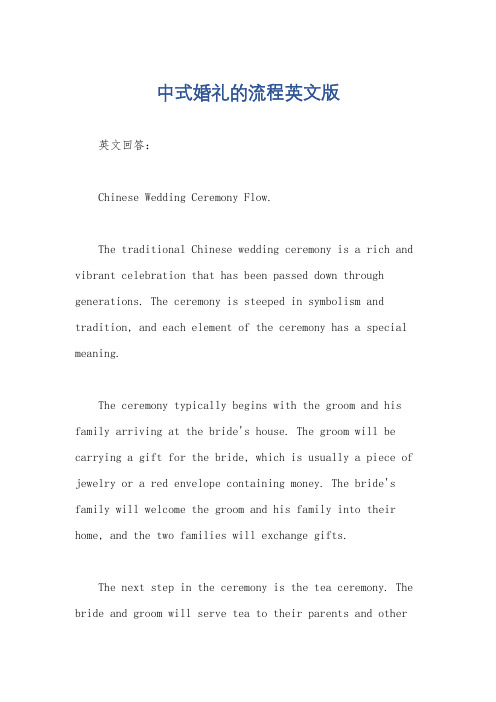
中式婚礼的流程英文版英文回答:Chinese Wedding Ceremony Flow.The traditional Chinese wedding ceremony is a rich and vibrant celebration that has been passed down through generations. The ceremony is steeped in symbolism and tradition, and each element of the ceremony has a special meaning.The ceremony typically begins with the groom and his family arriving at the bride's house. The groom will be carrying a gift for the bride, which is usually a piece of jewelry or a red envelope containing money. The bride's family will welcome the groom and his family into their home, and the two families will exchange gifts.The next step in the ceremony is the tea ceremony. The bride and groom will serve tea to their parents and otherfamily members. This is a symbolic gesture of respect and gratitude. The bride and groom will then exchange wedding rings.After the tea ceremony, the bride and groom will be led to the altar. The ceremony will be officiated by a priestor a master of ceremonies. The bride and groom will exchange vows, and they will be pronounced husband and wife.The ceremony will conclude with the bride and groom being led to the bridal chamber. The bridal chamber is a room where the bride and groom will spend their first night together as husband and wife.中文回答:中式婚礼流程。
传统中式婚礼(英文版)

When the night falls, the teasing game starts. Usually , all the young men can participate in the game , except for the bride’s married brother-in-law. Those funny and silly game will ease the tension, since the newlywed never meet each other before the wedding.
OK, let’s show you the part.
M: Now, bride and bridegroom ,please come here and kneel down.
M: First, bow to the great heaven and earth!
M: Second, bow to the great parents!
Then, the bride will kneel down to say goodbye to her parents while the bridegroom just bow to them.
♥ Part 2 送亲
Accompany bride to bridegroom’s family on wedding day
Mher!
Now , the ceremony is over. please send the bride to the bridal chamber (洞房).
中国传统婚礼英文介绍
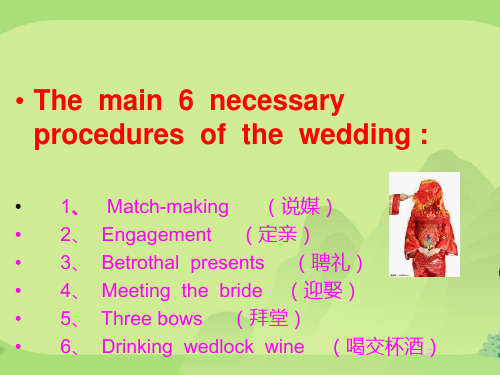
• (purpose : to counteract evil force .)
• One bows to Heaven and Earth • Two pays a visite to parents
• Husband and wife bends down face to face
• Be sent in a bridal chamber!
•
Red is central to the wedding theme of China .It signifies love ,joy and properity and is used in a variety of ways in chinese wedding traditions. Eg :Wedding 、 gown 、 shoes 、 package 、 quilt 、 pillow extra。
Combing Hair :
The first combing symbolize : from beginning till the end.
.
The second combing symbolize : harmony from now till old age.
The third combing symbolize :
stride the fire pan(跨火盆) Arm-crossed toast (交杯酒)
花生
chestnut 栗子
• longan 桂圆 Two pays a visite to parents
3、 Betrothal presents (聘礼)
The second combing symbolize :
(purpose : to kicked off the bride's pride .
中国婚礼习俗 (英文版)

Proposing: when a boy's parents intended to make a match, they would invite a matchmaker to propose with them at the girl's home. It was the custom that the first time matchmaker went as a guest they could not be served tea in order not to 'lighten the marriage'. If the proposal was successful, however, the matchmaker (usually a woman) would be rewarded with profuse gifts and feasts to show the two families' gratitude. Many unmarried young people could not see and were unfamiliar with each other till their wedding day. Birthday Matching: after knowing the girl's full name and birthday, they would ask a fortune teller to predict whether that could match their son's and whether there would be a happy marriage. The Chinese zodiac would be surely taken into consideration.
中国婚礼的风俗英文作文

中国婚礼的风俗英文作文Title: Traditional Chinese Wedding Customs: A Colorful Cultural Tapestry。
1. Burst of Red and Gold: 。
In the heart of China's vibrant tapestry lies a wedding ceremony, a symphony of vibrant hues and rich traditions. The moment the groom steps into the bride's home, it's not just a union, but a spectacle of red and gold, symbolizing prosperity and good fortune.2. The First Look: 。
The ceremony begins with a 'gaze exchange', a custom where the couple, dressed in their finest, silently lock eyes, a test of love and commitment. It's a moment ofsilent understanding, bypassing the need for words.3. The Red Thread: 。
The red sash, or 'honghao', ties the couple together, a metaphor for the unbreakable bond. It's a physical manifestation of the ancient belief in a cosmic connection, passed down through generations.4. The Bridal Dress: 。
英语中国传统婚礼习俗

must cry with her mother
二.陪嫁女婢
some maids might be
sent to marry her hostess’ husband-to-be by the sedan carried by two men.
迎亲
三. 轎前嫁妆 a dowry or the bottom drawer
新人利是、首飾。 offer a cup of tea 新人向其他長輩及親戚奉茶。
the jewelry
Lucky money
食酒婚桌wedding banquet
lucky candy
wine drunk at a wedding feast
入洞房Go to the bridal
chamber
中国传统婚礼
The marriage system of Ancient China
刘燕华 谢家蜜
刘敏君
迎親
一.新娘轎裝備 中上流人家用四人抬轎,
一般人家則用兩人抬轎。
花轿bride's sedan
迎亲的行列
music and firecrackers.
哭嫁
the bride, covered by a red head-kerchief,
鬧洞房: To tease the new
cou ending
四. 服饰
wedding full dress
结婚仪式
一拜天地 1 bow to the heaven and earth .
二拜高堂 2 bow to their parents 夫妻对拜 3 bow to each other
跪拜禮習俗
中国传统婚礼习俗英文版
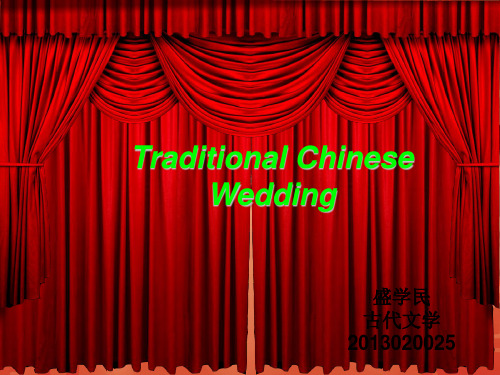
盛学民 古代文学 2013020025
纳采
问名
纳吉
Six kinds of etiquette
纳征
请期
亲迎
2
part one 纳采
It commonly known as matchmaking, the man ask matchmaker to went to the woman's home to propose marriage , when the woman's family agreed to the marriage proposal, then the man went home to prepare gifts to the proposal
part four 纳征
Also known as a big etiquette, the groom's side selected auspicious day to hold a engagement with the bride.
part five 请期
Choose an auspicious day to get married, In ancient times, generally we regard bimonthly and doubleday as auspicious, and people don't like to choose three, six and November, because three sounds like separate, six means they only have half of the life together, in short, those days are unlucky
- 1、下载文档前请自行甄别文档内容的完整性,平台不提供额外的编辑、内容补充、找答案等附加服务。
- 2、"仅部分预览"的文档,不可在线预览部分如存在完整性等问题,可反馈申请退款(可完整预览的文档不适用该条件!)。
- 3、如文档侵犯您的权益,请联系客服反馈,我们会尽快为您处理(人工客服工作时间:9:00-18:30)。
盛学民 古代文学 2013020025
纳采
问名
纳吉
Six kinds of etiquette
纳征
请期
亲迎
2
ቤተ መጻሕፍቲ ባይዱ
part one 纳采
It commonly known as matchmaking, the man ask matchmaker to went to the woman's home to propose marriage , when the woman's family agreed to the marriage proposal, then the man went home to prepare gifts to the proposal
part two 问名
It commonly known as the horoscopes, asked the matchmaker to ask the woman birth and name, so that they will know if they are suitable for each other
part four 纳征
Also known as a big etiquette, the groom's side selected auspicious day to hold a engagement with the bride.
part five 请期
Choose an auspicious day to get married, In ancient times, generally we regard bimonthly and doubleday as auspicious, and people don't like to choose three, six and November, because three sounds like separate, six means they only have half of the life together, in short, those days are unlucky
part three 纳吉
The groom's side divines there will be a auspicious fortune, then they prepare gifts for the ceremony, and make a notice to the bride's side, the wedding tentatively agreed
part six 亲迎
At the wedding day, the man with a welcome letter to the woman home to marry the bride personally.
That’s all ! thank you!
